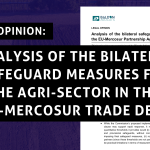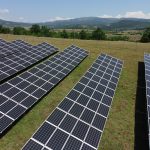FACTSHEET
Buildings still cause 36% of the EU’s energy-related greenhouse gas emissions. But solutions have already come into reach: For the houses, we’re living and working in, the energy transition means a deep renovation wave and a switch to renewable heat.
Buildings are the EU’s most important energy consumer. They caused 40% of the EU27 final energy consumption in 2019.[i] While the energy transition in the industry sector relates to a limited number of factories only, the challenge is much bigger when it comes to the homes and workplaces of more than 450 million EU citizens. They all need to be made compatible with the net-zero emissions objective by 2040. Otherwise, it will become unlikely that the EU will be able to reduce emissions in line with the 1.5°C thresholds of the Paris Agreement.
Our buildings are still too wasteful…
The buildings sector is lagging behind the EU’s climate and energy targets. Progress in energy savings has been limited. Three out of four buildings are classified as inefficient.[ii] Only 1% of the EU building stock undergoes each year a renovation that has a significant impact on energy performance. Usually, most refurbishments do not lead to any energy savings at all. Worryingly, the annual share of deep renovations that cut more than 60% of the final energy demand is only ca. 0.2%.[iii]
…and they strongly depend on fossil fuels.
The heat, as well as the electricity supplied to buildings, originates by three quarters from fossil fuels.[iv] The sector is thus responsible for ca. 36% of the EU’s greenhouse gas emissions. With 2.7m newly installed heating appliances in 2015, individual fossil gas boilers were still the by far leading heating technology for newly built or renovated residential houses in the EU.[v] Given the average lifetime of these inefficient boilers, buildings risk being locked into a high level of greenhouse gas emissions for the next decades.
Combine energy efficiency and renewables
Two developments need to go hand in hand to make Europe’s building sector compatible with the Paris Agreement: reducing energy demand through energy efficiency measures in parallel with increasing the use of renewable energy sources. Only their combination makes the energy transition a success:
-
A highly efficient building can save a lot of energy. But it still requires energy input for heating rooms and water. In case this energy input – even if strongly reduced – still comes from fossil fuels, then greenhouse gases will continuously be emitted into our atmosphere.
-
In theory, there are little hurdles to technically supply the existing building stock exclusively with renewable energy sources. However, substituting the wasteful fossil fuel consumption just with the same quantity of renewable energy sources would slow down the energy transition. It still would be a wasteful and expensive use of primary energy. And it obviously would take more time to ramp up the renewable energy supply for buildings, while other energy sectors at the same time also try to mobilise the easily accessible renewable energy potentials for their needs.
Put energy efficiency first
The cheapest kilowatt-hour is the one that you just don’t consume. In our Paris Agreement compatible (PAC) energy scenario[vi], we describe how the building sector can save roughly two-thirds of its current energy demand by 2050. The energy efficiency first principle implies that a strong reduction of the energy demand is a prerequisite for any successful energy transition. This implies changing both, buildings and human behaviour.
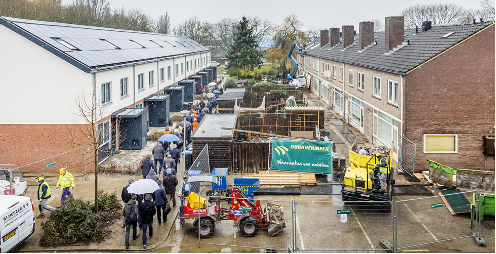
Deep renovation project in the Netherlands. Source: energiesprong.org
Studies show that the annual renovation rate needs at least to triple from 1% to 3%. This deep renovation wave means that all the buildings progressively undergo a fundamental refurbishment. The building envelope, i.e. the walls, the windows and the rooftops have to be better insulated to avoid energy losses during the heating season. At the same time, the buildings need to be better protected against heat in the summer to avoid energy demand for cooling them down. Our PAC scenario assumes that circa 70% of all renovations would be deep renovations that cut the energy need of the building by at least 60%. Depending on the architecture, the location and the specific needs and functions, such a deep renovation will not be possible in all cases. The remaining renovations however should cut the energy demand of the building by at least 40%.[vii]
It is not only the building’s envelope that defines its energy consumption. The people using the building also matter a lot. In our PAC scenario, we are optimistic with regards to potential behavioural changes. Improved awareness-raising and intelligent use of building automation technologies further help to decrease the final energy demand[viii]. Regulation and guidance are key in this area. The reason is that digitalisation could lead to energy savings but could easily also lead to an increased energy consumption if it is not properly managed.
Last but not least, the size of a building logically impacts its energy demand. Due to urbanisation, demographic and other societal trends, we expect a decrease in the average residential floor area per capita. The PAC scenario assumes a drop by 23% between 2015 and 2050.[ix]
Compared to other sectors such as industry, the residential and tertiary buildings sector can achieve much stronger energy savings. The reduction by two-thirds is already unique and even more important given buildings’ share in total EU final energy demand.
Supply 100% renewable energy
Using fossil fuels like fossil gas and oil in individual boilers means burning a finite primary energy source to harvest a limited output of space heat, mostly released through conventional radiators. Burning coal in individual stoves is even more inefficient, besides emitting dangerous air pollutants and greenhouse gases. Making buildings compatible with the Paris Agreement requires a 100% renewable heat supply.
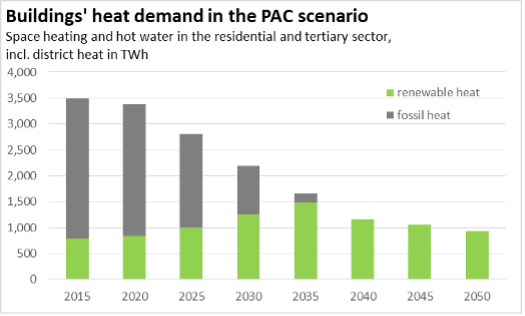
The PAC scenario shows how the remaining energy demand of the European building stock can be fully covered by domestic renewable energy sources.[x] Renewable heat will be brought to residential and tertiary buildings through two applications:
-
Many buildings can harvest the local renewable energy potential directly on-site through individual heating systems, such as electric heat pumps, by using solar thermal collectors or by burning sustainably sourced biomass in individual boilers. This is particularly the case in rural areas.
-
In more densely populated areas, buildings will increasingly be connected to district heat networks that transport hot water to the individual heat exchangers of buildings. District heat networks allow bridging the geographical distance between urban (and also industrial) consumption centres on one side and the renewable heat potentials on the other side. A broad range of renewable heat suppliers can feed into the network, such as geothermal heat stations, solar thermal collector fields, electric heat pumps as well as combined heat and power (CHP) plants only using sustainably sourced biomass.
Renewable heat is stable and flexible
We consider the building sector as a key for providing flexibility in an interconnected 100% renewable energy system. Heat pumps can ramp down their electricity demand in case of grid congestion. A variable price would give owners an incentive to react to oversupply. The combination of a number of renewable heat technologies in district heat networks allows for a better balancing of seasonal variations. For instance, the excess heat supply from solar thermal collectors during the sunny summer months can be absorbed by thermal storage capacities such as water tanks or aquifers.
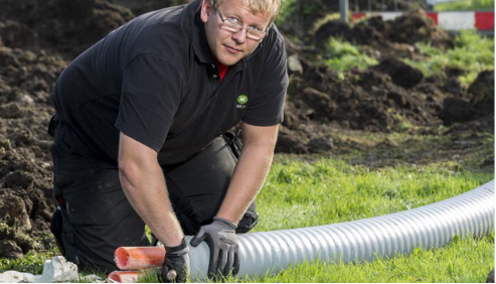
Installing a local district heat network in Germany. Source: AEE/Langrock
Like heat pumps, district heat networks will play an important role in easing the electricity grids. In the case of renewable oversupply, power will be converted into heat. The heat network functions as a buffer: several renewable heating and storage technologies can complement each other in a district heat network to even out the aggregated demand of many different consumers, including peaks during cold spells.
District heat networks also can collect the industrial excess heat from high-temperature processes. For instance, the steel industry releases heat that can’t always be used immediately on the premises.
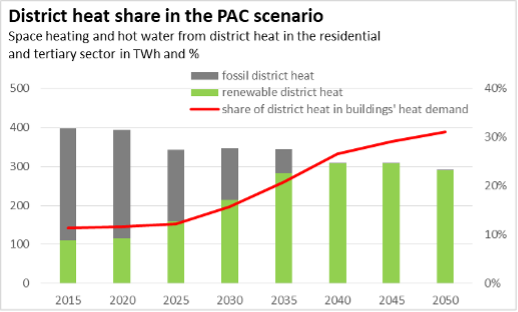
According to our PAC scenario, the share of district heat will gradually increase to cover almost one-third of the total buildings’ heat demand. By 2040, the entire heat supply of residential and tertiary buildings will be fully renewable. Fossil gas disappears by 2035. No fossil gas or hydrogen is needed as a backup. Given its high conversion losses and high costs, only a few industry sectors such as steel and chemicals will use renewable hydrogen for their production processes. Renewable heating solutions such as heat pumps are much more competitive and easy to roll out than building a hydrogen infrastructure in the buildings sector.[xi]
Roles of different renewable heat sources
-
In our PAC scenario, electric heat pumps that use renewable electricity to capture ambient heat or shallow geothermal heat are the dominant heat source. They also feed into district heat networks and cover 80% of buildings’ heat demand in 2040.
-
Industrial excess heat recovery is locally limited but offers an important potential tapped through district heat networks (7% of demand in 2040).
-
Solar thermal collectors on rooftops serve as individual heating systems. Large ground-mounted solar thermal collector fields feed into district heat networks (5% of demand in 2040).
-
Geothermal heat stations and CHP plants feed into district heat networks.
-
Direct electric heating with renewable excess electricity also feeds into district heat networks.
-
Solid biomass, i.e. burning wood waste and residues in individual boilers, decreases strongly to respect sustainability criteria while phasing out inefficient individual wood stoves by 2040. Instead of burning solid biomass for district heat, it is partly shifted to the chemicals industry as a feedstock.
-
Biogas will be produced exclusively from waste and residues for direct use in CHP on farms and in the food and beverages industry. The heat is either used on-premises or fed into district heat networks. Biogas upgraded to biomethane will not play an important role in heating buildings.
-
Municipal solid waste disappears from the mix by 2040 because of waste reduction and implementation of the circular economy approach.
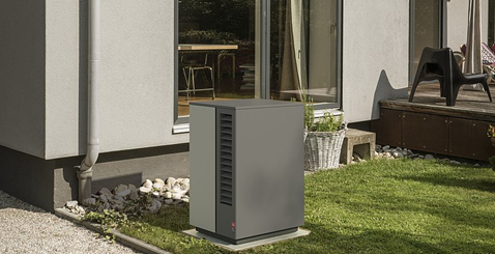
Heat pumps that capture ambient or geothermal heat will dominate the heat supply. Source: waermepumpe.de
Again: Combine efficiency and renewables
In short, the energy transition in the buildings sector implies a fundamental change in energy demand and supply. But how and when can all these fundamental changes be kicked off? The deep renovation wave is the window of opportunity for changing the energy supply of buildings. As a matter of fact, it simplifies the renovation when both the building envelope as well as the heating system are improved coherently. The moment when a house owner decides to refurbish the building is also the perfect time for switching to renewable heat. Exchanging a fossil fuel boiler with a renewable heating system is of course possible as a stand-alone measure. But if renovation measures cut the energy demand a few years later, the size and functioning of the renewable heating system might be suboptimal. The good news is that all technologies and measures described in this fact sheet are mature and introduced into European heat markets. There is no reason to wait any longer.
[i] European Commission: Energy statistical country datasheets, February 2021.
[ii] European Commission: New rules for greener and smarter buildings will increase the quality of life for all Europeans, April 2019; https://ec.europa.eu/info/news/new-rules-greener-and-smarter-buildings-will-increase-quality-life-all-europeans-2019-apr-15_en.
[iii] European Commission/IPSOS/Navigant: Comprehensive study of building energy renovation activities and the uptake of nearly zero-energy buildings in the EU, November 2019.
[iv] Buildings Performance Institute Europe (BPIE): On the way to a climate-neutral Europe. Contributions from the building sector to a strengthened 2030 climate target, December 2020.
[v] European Commission Joint Research Centre: Integrated Database of the European Energy System (JRC-IDEES), June 2018; https://data.jrc.ec.europa.eu/dataset/jrc-10110-10001.
[vi] CAN Europe/European Environmental Bureau: Building a Paris Agreement Compatible (PAC) energy scenario, June 2020; https://caneurope.org/building-a-paris-agreement-compatible-pac-energy-scenario.
[vii] Taking over assumptions from EUCalc: Technical documentation: WP2 –Buildings module documentation (including households and services). Preliminary version for expert review, April 2020, http://tool.european-calculator.eu.
[viii] Based on Fraunhofer ISI: Study on Energy Savings Scenarios 2050, January 2019.
[ix] Taking over assumptions from EUCalc.
[x] Renewable energy potentials for heating are partly taken over from Aalborg University: Heat Roadmap Europe 4. Quantifying the Impact of Low-Carbon Heating and Cooling Roadmaps, Oct. 2018.
[xi] Fraunhofer IEE: Hydrogen in the energy system of the future: Focus on heat in buildings, May 2020. Baldino, Chelsea et al.: Hydrogen for heating? Decarbonization options for households in the European Union in 2050, March 2021.

